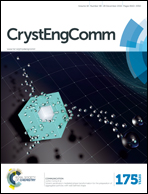The role of PLLA-g-montmorillonite nanohybrids in the acceleration of the crystallization rate of a commercial PLA†
Abstract
Employing the hydroxyl groups on the surface of Cloisite® 30B montmorillonite (Cl30B), the ring-opening polymerization of L-lactide was performed with a metal-free catalyst to yield a PLLA-g-Cl30B nanohybrid with low Mn grafted PLLA chains (i.e., 9 kg mol−1). This nanohybrid was then melt mixed with PLA 4032D from NatureWorks, which is a slow-crystallizing PLA as it contains 2% D-isomers and has a high Mn value (i.e., 123 kg mol−1). The samples were characterized by TEM, WAXS, SAXS, DSC and Polarized Light Optical Microscopy (PLOM) in order to study their crystallization kinetics in depth. The dispersion of the nanoclay was excellent and much better in the PLA/PLLA-g-Cl30B nanocomposites in comparison to PLA/Cl30B blends prepared as reference. In order to ascertain the role of the nanoclay, analogue PLA/PLLA blends without Cl30B were also prepared. The spherulitic crystallization kinetics from the melt was determined for all samples. The growth rate of neat PLA was accelerated approximately 3 times by incorporating the PLLA-g-Cl30B nanohybrid with an inorganic content of 5%. The overall crystallization kinetics from the glassy state of PLA was also accelerated in a similar way by the nanohybrid addition. Nevertheless, the PLA/PLLA blends crystallized even faster indicating that the dominant effect that causes the acceleration of the crystallization of PLA is the plasticization of PLA by the low Mn PLLA molecules. The changes in Tg of PLA also support this explanation. In the case of the PLA/PLLA-g-Cl30B nanocomposites, even though the plasticizing effect of the PLLA chains still dominates, their action is counterbalanced by their tethering on one end, as they are grafted to the surface of the exfoliated clay nanoplatelets.



 Please wait while we load your content...
Please wait while we load your content...